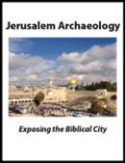
Kedesh, located in northern Israel, served as a busy administrative center for the Ptolemies in the third century and for the Seleucids in the second century BCE. It was abruptly abandoned around 150 BCE, and this power vacuum contributed to the success of the Maccabees. Photo: Courtesy of the Tel Kedesh Excavations / Sharon Herbert & Andrea Berlin, Directors.
Who were the Maccabees, what did they do?
From priests to kings, the Maccabees created an independent Jewish kingdom in the second century BCE. Their success was a testament to their zeal—and some significant external factors. The Book of 1 Maccabees tells the story of their rise, while archaeology places the story within a larger historical and political context. Andrea M. Berlin of Boston University analyzes both in her article, “The Rise of the Maccabees,” published in the Summer 2023 issue of Biblical Archaeology Review.
There are several ancient texts that describe the Maccabees’ rise to power. These include the apocryphal books of 1 and 2 Maccabees, as well as the writings of Josephus, a Jewish historian who lived in the first century. They detail the events, summarized below, which transpired in the second century BCE and led to the foundation of the Hasmonean Kingdom.
The Rise of the Maccabees, According to History
(1) In the mid-second century BCE, the Seleucid Empire controlled Judea and promoted Hellenistic (Greek) culture and religion. Some Jews embraced this, but others did not.
(2) The Seleucid ruler Antiochus IV escalated tensions by sacking Jerusalem, building a fortress (called the Akra), sacrificing a pig in the Jerusalem Temple, and issuing an edict to abolish Jewish law and worship.
(3) In opposition, Mattathias Maccabee, a Jewish priest, and his five sons, John, Simon, Judah, Eliezer, and Jonathan, started a rebellion c. 167 BCE. They gathered forces and fought against the Seleucid rulers and those who supported them.
(4) The Maccabees suffered loss, with Mattathias, John, Judah, Eliezer, and Jonathan all dying in battle. Nevertheless, they managed to rededicate the Temple and reclaim Jerusalem and Judea. They established an independent Jewish kingdom, called the Hasmonean Kingdom, with Simon Maccabee as its first ruler c. 142 BCE.
(5) Later Hasmonean rulers continued to expand their kingdom into Samaria and Galilee. Some even took the title of king.


The Hasmonean Kingdom c. 110 BCE. Who were the Maccabees, and what did they do? The Maccabees were a priestly family who founded an independent Jewish kingdom, the Hasmonean Kingdom, in the second century BCE. Map: Biblical Archaeology Society.
The Rise of the Maccabees, According to Archaeology
To gain another viewpoint of these events, Andrea M. Berlin takes readers on an archaeological survey of the regions that became Maccabean territory: Judea, Samaria, and part of Galilee. In cities and villages across Galilee and part of the coastal plain, she sees a recurring pattern: Sites prospered and reflect a Hellenistic culture during the beginning of the second century BCE, but then they were abruptly abandoned or destroyed in the 140s BCE. Later in the second century BCE, they were resettled and reflect Jewish life and culture.
The interpretation seems clear: The Seleucids controlled the area and promoted Greek culture and international trade networks. Then they abandoned the area; something forced them out. Later, Jews resettled these areas as part of the Hasmonean Kingdom.
Historical texts credit the Maccabees as being the force that drove the Seleucids from those lands, but Berlin believes that the archaeological remains tell another story. The sites reflect decades of tension between the two major powers in the area: the Ptolemaic Empire, based in Egypt, and the Seleucid Empire, based in Syria and Turkey. Both desired the region, tried to exert their influence over it, and fought each other repeatedly to gain control over its territories. That fighting, as well as infighting among Seleucid factions, is what caused the destruction and abandonment of Galilean sites in the middle of the second century BCE. The land then lay abandoned for about 20 years before being resettled as part of the Hasmonean Kingdom. Berlin explains:
The brutal events of the late 140s left broad regions with abandoned settlements and broken networks. It is exactly inside this moment that Simon retakes the Akra in Jerusalem—an event that, considering how factionalized and otherwise occupied the competing Seleucid forces were, may now be seen as more opportunistic than organized.
The Maccabees certainly had some victories, but they also benefited immensely from the fighting between the Ptolemaic and Seleucid empires. Essentially, they walked into a power vacuum, which enabled them to establish their kingdom. To learn more, read Andrea M. Berlin’s article, “The Rise of the Maccabees,” published in the Summer 2023 issue of Biblical Archaeology Review, and explore the Special Collection of articles on the Maccabees, “Meet the Maccabees,” in the BAS Library.
BAS Library Members: Read the full article “The Rise of the Maccabees” by Andrea M. Berlin in the Summer 2023 issue of Biblical Archaeology Review.
Not a BAS Library or All-Access Member yet? Join today.Read more about the Maccabees in Bible History Daily:
Read more in the BAS Library:
Inscription Reveals Roots of Maccabean Revolt
The post Who Were the Maccabees and What Did They Do? first appeared on Biblical Archaeology Society.
The post Who Were the Maccabees and What Did They Do? appeared first on Biblical Archaeology Society.



0 Commentaires